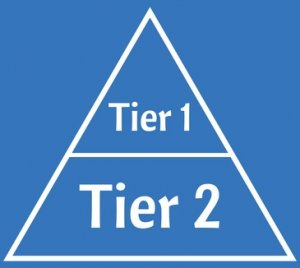
Tier 1 advertising networks are essentially Google, Bing, and Yahoo. Any other search engine falls into tier 2. They may not get the most traffic (Google and Bing take up 96% of all search, anyway), but they do target markets otherwise overlooked.
Essentially, when you’re planning your PPC campaign, you don’t want to overlook the second tier.
So after you’re done enjoying the alliteration in the title of this article, we can move on to some solid tips to take full advantage of tier 2 advertising.
If you’re wondering, ten is an arbitrary number, chosen solely for the alliteration.
Now, let’s count backwards, for fun.
TIP 10: Explore Your Options
There are only three tier 1 advertising networks. There are countless tier 2 search engines, each catering to a different set of people. AOL and Ask.com are the two largest, but so many more exist. Such as eZanga and Business.com.
You can even set up PPC campaigns on dating websites, like Plenty of Fish. Anywhere that hosts online advertisements, really.
Just make sure you do your research. Look at costs, average conversions, the cost-per-conversion, and reviews of the service. Some low-key offerings have issues with click fraud, which results in ingenuine clicks and increased costs. The more reputable networks offer click fraud protection.
So where should you host your campaign? Well, it really depends on your niche.
TIP 9: Target Your Niche
This is fairly self-explanatory, but something that not many advertisers think about. When you advertise with Google, you use keywords to distinguish between audiences and niches.
With tier 2 ad networks, you can go further and select only the search engines that reach your audience. If your main focus is B2B services, you might want to advertise on Business.com. If you have a new dating app, you could consider Plenty of Fish for promotion. How convenient!
This tip goes along with doing research. Be sure to explore all of your options and determine which places would be best to advertise with. You want to reach as many potential customers as you can to be sure you’re getting the best bang for your buck.
TIP 8: Use Relevant Keywords
Just because you’re using a niche advertising network doesn’t mean you can stop optimizing your keywords. This is still important, to further segment your markets. And it could save you oodles of noodles. AKA ca$h money.
Long-tail keywords play a crucial role in advertising. For instance, you can aim your life insurance ad at those searching for “insurance.” However, this can be costly and will reach anyone looking for any type of insurance. It’s not an efficient approach. By including specific terms in your keywords, you can focus your target audience better and achieve more consistent conversions and clicks.
Utilizing these tools will allow you to reach a very specific group of people. You can then optimize your campaign to cater to this specific group.
TIP 7: Optimize Ads and Landing Pages
So… yeah. This is important in any PPC campaign. You want to create a landing page for your ads, and make sure they feed off each other. And you want to optimize both your ad and landing page to cater to those who are interested in what you offer.
If you’ve discovered which ads and landing pages work on your Google AdWords campaign, you have to decide if you want to use those as-is in your tier 2 ad campaigns. Maybe they will work just as well, or maybe you need new ads and landing pages that focus solely on the target niche of these search engines.
Ultimately, you need to run tests on your ads as you would in any other ad campaign.
TIP 6: Test, Test, Test
This is crucial. We emphasize this in almost every post for a reason. You can’t just plop ads up and let them go. You may be running inefficient ads that aren’t garnering conversions, causing you to spend money on nothing.
Set up tests for your ads every time. You want to see which ads are most effective for each audience on each platform. Do the same thing with your landing pages. See which lead to the most clicks or conversions, and stick to them. They may be different than the ones you use for other campaigns.
Since tier 2 networks target specific niches, they may not work for your campaign. That’s why you need to test and constantly monitor your progress.
TIP 5: Track Your Campaign Closely
If it’s not working, you don’t want to leave it up for too long. Give it time to run, and decide if it’s good, if it needs tweaking, or if it’s just not working.
Some networks send you really informative reports on how your campaign is going, which help you narrow down where any problems lie. Google offers AdWords scripts, which can be used to create helpful report templates or cancel campaigns that aren’t running well. Other platforms may offer similar features, be sure to ask about them.
TIP 4: Don’t Be Afraid to Ask for Help
There are literally tons of sources online with templates, reviews, suggestions… anything really. Even if you don’t find what you need, there are countless forums with members who will answer your questions.
If you’re clueless, there’s plenty of help to go around. We won’t judge, I have asked for help so many times.
The best help can actually come from the network itself. They usually have reps who are more than happy to optimize your campaign.
TIP 3: Work With Your Account Rep
Since they have smaller traffic and a smaller customer base, tier 2 advertising networks are more able to cater to you. Your account representative will usually be more than happy to answer any questions or offer any resources that will make your experience as great as it can be.
Google and Bing have a much harder time offering this, since their customer base is so vast. They can’t possibly cater to each individual person.
Building a relationship with your account rep can lead to better ad campaigns and better odds of refunds, if necessary. It’s just a little perk that tier 1 networks have a hard time offering.
TIP 2: Still Use Tier 1 Ad Networks
All of this talk about tier 2 shouldn’t make you abandon ALL of your tier 1 ad campaigns. If you know what you’re doing, Google and Bing ads can rake in a LOT of clicks. After all, they take are used for 96% of all web searches.
Yes, tier 2 search engines are important, and are mostly an untapped goldmine. But they need to be used alongside your primary tier 1 ads. Diversify your ad campaigns among multiple networks, and optimize them for each platform.
Don’t use one solely, we’re just trying to make a point that you need to explore all of your options to make the best decision for you or your company.
TIP 1: Don’t Spend TOO MUCH Time On It
Tier 2 networks take up 4% of all online search traffic total. They’re important to consider, and they can make you great profit if you use them right. But if you follow all of the tips above and still can’t make a profit, don’t sweat it.
In the end, your Google AdWords campaigns might still bring you the most traffic.
In addition, if you are seeing success with your tier 2 campaigns, great! But still don’t spend too much time managing them. Once you find what works, you don’t want to continue to micromanage like you would with your Google campaigns. Consider them as an addition to your primary advertising. Take time, but don’t take up your whole day trying to work with it.




